Jennifer Ware, University of North Carolina, Chapel Hill
Enculturation: http://enculturation.net/composing-in-the-dark
(Published: October 10, 2012)
Compositionists often assign multimedia projects in their classrooms. While we focus on the rhetorical choices and technological skills needed to create these texts, we do not often explore the role that mental imaging and affect play in the planning and composing process. At Computers and Writing 2012, a Light Painting ConstrucTEXT session incorporated long-exposure photography and LED Light Painting to compose with the texture of light. By using familiar technology to compose in unfamiliar ways, participants were able to pay attention to the pre-planning process of creating a composition and better externalize how their own composing processes function.
Because I believe that the best way to learn about light painting is to experience it, this essay is divided into several sections: the first outlines light painting, the second includes personal reflections from participants at a ConstrucTEXT session held at Computers and Writing 2012, and the third offers a practical list of tools needed to create a "light painting kit."
I. What is light painting?
Light painting is a combination of manual bulb photography and painting. However, instead of using a canvas and paint brushes, the camera lens is used to define a scene as "the canvas," and the "paint brushes" are LED lights. By working in the dark and using the texture of light to illuminate the canvas, light painting offers students the opportunity to explicitly reflect upon their internal composing process.
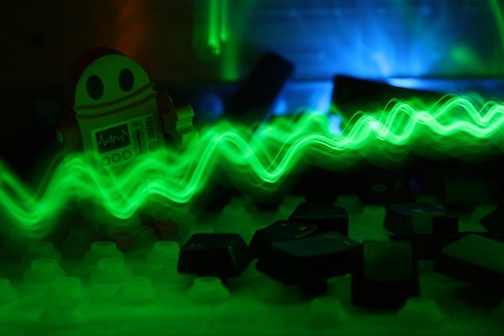
Figure 1: Robot and Force Field
Light painting involves long-exposure photography (10 seconds) and "painting" an area in front of the camera with LEDs. I've found this process to be quite valuable in how it has enabled me to think about photography, reflect on my framing, and explore how and why I compose. For example, in my previous profession as a broadcast journalist, the composing process I used to tell news stories was almost entirely internalized so that my shot choices were automatic. In the classroom, students may experience a similar automatic process in which composing appears to be a series of linear steps performed from start to finish. Only through disruptions of those familiar automatic steps with new situations or unfamiliar tasks are we able to step back and pay attention to the process of composition (Davidson 49). I assert that light painting is a visual and material composing process that disrupts the automatic progression of writing and revising a text so that students realize that we are always in a state of composing rather than discrete moments of composition.
With light painting, the final composition isn't visible until after the shot has been recorded by the camera. Because gestures, motion, and human movements are involved in the process and are rhetorical composing choices available to the participants, each composition is unique. Therefore, the composition of the shot and patterns of light movement must be pre-planned before clicking the shutter. There is always a degree of play and exploration to see how different LED bulbs affect the shot, but even then, the students must make explicit choices about what materials to use and how to explore the unfamiliar environment. Students make these choices by mentally imagining what the final product might contain and/or how their movement of the light will be exposed upon the canvas. Unlike drafting with text in a word-based document, it is not possible to revise or edit that particular composition once it has been captured by the camera. However, the learning experiences and composing processes from each image can be built upon to create new light paintings and refine compositions. Anne Wysocki has argued that awareness of the materiality of specific materials we as composers choose while creating our texts is essential to the creation of new media texts (15). For this project, students use the information they gather from creating previous compositions in order to form future composing choices that shape the next light painting they create. The students’ eventual awareness of the specific, concrete qualities of the physical materials used during light painting and the effect each material has upon the range of possible final images invites further creation of new compositions and ways of interpreting what it means to compose. This exploratory and unknown environment affords participants a context in which to explore the affect (Murray 83) of composing and potentially find punctum, or the details that extend the life of a composition beyond the image (Barthes 40), because of “accidents” within the frame.
Photography and Affect
Figure 1 displays a light painting taken with a 50mm lens. Like many photographs, there is a framed scene with a distinct focal point. With light painting however, the composer works in the dark to leverage the qualities and textures of specific light sources (in this case Holiday bulb lights and LEDs). The frame within the lens is like a painter's canvas. The camera is manually focused on the object of interest, the shutter is clicked, and the small lights are used to paint and light the scene. For this particular photograph, I wanted a depth of field large enough to have some of the light in focus (the force field) but not too much so as to create a flat picture.
The Texture of Light and Punctum
A green holiday light was used within Figure 1 that creates a force field barrier in front of the approaching robot. The green light was used in a back-and-forth wavy motion to create the pattern in the image and then "swooped" in the background of the image. The pattern of green ribbons of light following the wave like pattern was due to the movement and the shape of the bulb. At the same time, a blue holiday light was buried underneath a pile of keyboard keys in the background. This created the blue highlight off of the keyboard circuit in the background. The punctumnot passed in front of the camera shutter. Not every light painting contains a detail that extends the thought processes beyond the compositional frame. However, the "accidents" that occur when one is light painting can provide inspiration that furthers exploration of unfamiliar mediums.
Because the Computers and Writing theme was architexture, "old technologies" were gathered and taken apart to make the scenes. For example, the bumpy pattern on the floor of Figure 1 is the mesh framework from the inside of the keyboard. In the foreground and background are additional pieces of the keyboard. These “old technologies” (broken cassette tapes, keyboards, VHS tapes, motherboards) provided the architectural framework for new advances in future computing and composing technologies. Although the keyboards were initially broken and no longer fulfilled their primary function of adding code or computer text, they became new discoveries and future ideas when students used them as light painting backdrops to explore what an electrical current might look like between the keys. The old flow of a writer's ideas became new streams of light, mimicking the electrical current of thoughts that flow from our brain through our fingers and onto the screen. Within the pictures below you can see the differences between the colors and shapes of the lights used to paint the composition. In some cases, the colors of the lights combine to form new colors that were not originally used to paint the canvas.
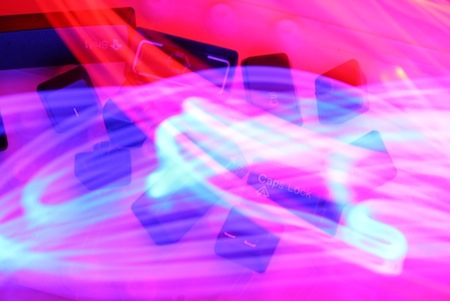
Figure 2: Using Light to Obscure
In Figure 2, a red holiday bulb was first used to paint the scene, and 5 seconds later a blue LED was painted in the frame. In this case, the lights were not used at the same time as one another, but the camera captured both and created the purple/pink hue visible within the final image. Depending upon the amount of time the LED is used in front of the lens, light can be used within the frame to obscure, rather than reveal the background objects. By working in the dark and focusing on the properties and textures of light, the compositions take shape in new and exciting ways. Generally with photography a light source that is too bright can "blow out" or overexpose portions of the photograph. With light painting, however, the blue light in Figure 2 obscures the background rather than overexposing the entire scene. Using light to conceal rather than reveal is just one of many exciting composing choices available during the light painting process.
This work is fused with my interest in photography and bricolage (Shipka), and is inspired by Aldwyth’s work v./work n. in which she remixed found objects to create new pieces that conveyed multiple meanings (56). I've also incorporated my interest in the Arduino and night photography to guide my experience with light painting. While to some this may look like a purely artistic creation, the process of this style of work has informed my thinking about what it means to compose and create with digital technologies. Playful exploration mixed with increasing reflection upon the previous compositions enables one to compose with light in this fashion. Although students can mentally compose and partially visualize the scene before creating it (think of it as internal storyboarding for filmmakers), only after the piece has been recorded are they able to see what has been captured. And only once do they have opportunity to shape the light for that 10-second time frame. As such, no recorded composition is ever the same as the one before. The finished composition serves as a record of a student’s movement within the frame and upon inspecting the composition, s/he automatically reflects upon the movements and lights, the composing processes that created the composition.
Although these pictures are very interesting to look at, I believe experiencing the composing process through light painting is where the punctum and affect of these photographs can be found and further explored. Because of the processing capabilities of digital camera with extended exposure shutters, I believe some of the affect is inherently built into the process of composing. After the shot has been taken, the camera takes a few seconds to record the photo before displaying it on a built in LCD screen. This sense of anticipation builds over time as students wait impatiently to see what they have created. In the next section, participants of the Computers and Writing ConstrucTEXT session share their experiences and discuss waiting for their compositions to render.
II. The ConstrucTEXT Session
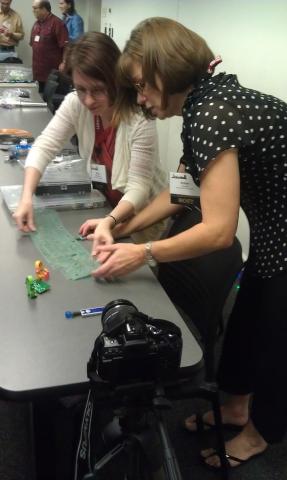
Figure 3: Dana and Robin Set Their Scene
At Computers and Writing 2012, sixteen participants attended a 90-minute session to play with Light Painting. I choose the word play specifically because in some sense, playing and experiencing making light paintings is the first step to explore the affect of one's composing process. Participants were placed into groups of four or more, provided a "light painting kit" with verbal instructions and visual examples, and then began to play. Each group used a DSLR camera on a tripod that had the following pre-defined settings: 200ASA, 5.6, 10-second exposure. In my previous work I've found that these settings provide the best capture of the color and light textures. Because of this, other than manually focusing and pushing the camera shutter button, the participants did not need to be familiar with the particular type of camera. The groups selected materials for their compositions from a set of found materials: records, broken cassette tapes, keyboard parts, eraser robots, buttons, small figures, and motherboard pieces. They set up their first scene while the lights were still on. After that, they worked in the dark (with holiday lights in the corner to provide safety lighting of course).
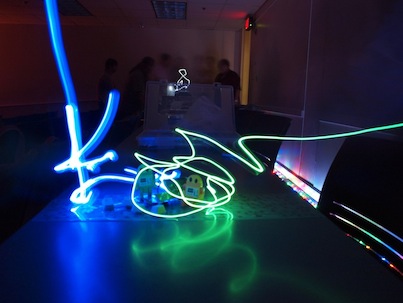
Figure 4: The First Shot
Several photographs taken by the groups at the session are listed below along with a comment from one of the group members about their light painting experience. The photographs are not processed in any way but are the original light paintings they produced during the session.
Robin Snead, English faculty member at UNC-Pembroke and PhD candidate from the Communication, Rhetoric, and Digital Media (CRDM) program at NC State described her group's composing process:
In creating our first scene, we wanted to represent CRDM, since everyone in our group was connected to the program. We selected the two robots erasers, because CRDM has a robot designed by Kelly Martin as our (unofficial) mascot. To fill out the scene, we grabbed a few spare computer parts, and we found the letters “CRDM” from a bag of discarded keyboard keys. Tape pulled out from a discarded music cassette offered background and texture. As we staged, I’m sure we were subconsciously affected by seeing light painting photos Jen Ware had taken with Lego minis and how those scenes were composed. One thing we had to learn was how tightly the shot needed to be framed; in our first shot, we captured too much of our surroundings, and our scene was a bit lost (Snead).
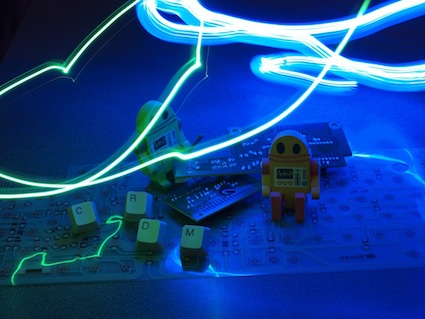
Figure 5: CRDM Robots
After their first shot in Figure 4 above, the group adjusted the framing and took several new shots. Robin's favorite is below in Figure 5. After the workshop, she reflected on her experiences with light painting.
The process of composing in an unfamiliar medium—one I had zero experience with—made me think about the rhetorical choices I ask students to make every day—often in genres that they have little or no familiarity with, and sometimes with tools they have no experience using. We began with this concept of what we'd want the shot to look like, but because we were newbies, it took playing around with the different lights, and with different movements, to figure out how to get the effects we wanted. That's so much like rhetoric, but also so much like art. The darkness, combined with the LED lights and the length of the shot exposure, meant that we couldn't really know what the end result of our actions would be. The anticipation was addictive (Snead).
For Robin, the affect she experienced (the growing anticipation about what the light painting would look like) while waiting for the composition to display on the camera screen and during the analysis of the group's final product, prompted further exploration to see how different lights and surfaces worked in the dark. In the Figure above, the thick blue light is from an octagonal-shaped bulb while the green is a regular Christmas bulb. Because of the size difference, the lights create different patterns and spills depending upon how fast they are moved and how long they remain on near the frame. The group also discovered that different surfaces, like the keyboard circuitry the robots are sitting on, reflected the LED lights to produce new patterns. The green circuit-looking line traced from the "R" letter to the edge of the circuit board was not intentional, but was a reflection of the green LED above.
?
People in the frame

Figure 6: People as Objects of Interest
Several of the groups also used people as their focal point within the frame. In Figure 6 a blue light stick provided the key light source for the photograph. A secondary light source, a string of holiday lights plugged in about 10 feet away from the camera cast the extra light on the right side of the participant’s face. Adam, a PhD student from UNC-Chapel Hill, remained as still as possible for the 10-second exposure. At the same time, he moved the light stick slowly back and forth to create a sense of movement within the frame. In Figure 7 the group attempted to create a reindeer-like sculpture using Sydney Stegall, an undergraduate a UNC-Chapel Hill, as their muse. Adam Engel, a PhD student in Rhetoric and Composition at UNC-Chapel Hill described what it was like to compose these shots:
My group's light painting seemed to draw on thought processes similar to those used in written composition. Though we can thoroughly outline a written piece before drafting it, we are often surprised by the direction in which the actual writing progresses. Light painting forced my group to confront this uncertainty; we were literally "in the dark" as we waited for our finished photos. The activity took on a sculptural quality when we used each other as bases for painting. Clean-shaven faces ended up acquiring a robotic, shimmery vagueness, and standing figures suggested the imposition of imaginary objects such as lightsabers and Rudolph-noses. Light interacted with our living subjects in ways we could direct if not fully control. This process also traced—again, literally—the uncertain dynamics of collaboration. Each member contributed unique motions and, when we used them as canvases, facial features that produced bizarrely satisfying results. Light painting brings the innovative, spontaneous aspect of composition into a spatial dimension, throwing a new light on the way our minds work together (Engel).
By the end of the 90-minute session the participants kept wanting to take "just one more shot" (several times over and over). While the session was just enough time to begin exploring how to compose and create light paintings, Ashley Hall, a PhD Candidate at UNC-Chapel Hill, thought a longer workshop would have been more helpful.
I felt like there wasn't enough time for me to really appreciate all that the session had to offer. During the session I had difficulty using the tools to make something because I wasn't sure what I wanted to say nor did I know how to use the tools to say something. If I were to use this as an in-class activity, I'd have a group workshop like this session, then have the students go home and continue to compose on their own. Later that week the groups would work together again using the learning experiences from the solo composing sessions. I'm still reflecting on the ConstrucTEXT session a week later and feel like I needed more time to explore how all of the lights worked. This activity was just a starting point; if I continue to try light painting I feel like I'll be able to better describe the process and understand how to use the tools to say something (Hall).
In this case, Ashley expressed feeling "something" about composing with lights but was unable to describe or pinpoint the feeling related to creating a composition. The uncertainty she experienced with the unfamiliar medium is similar to the first time students begin composing with a new genre. With additional exposure to the style of composing within specific genres and mediums, students are able to better understand the composing choices available to them and how those choices affect the overall composition. Adam Engel on the other hand, recognized a "bizarrely satisfying" feeling when seeing the compositions on the camera screen. This is a recognition of affect at work while creating an image. Affect is an emotional charge connected to an image yet may be difficult to describe or ascertain other than a feeling about something taking place (Murray). This recognition of excitement or feeling during and after composing a light painting, I believe has the ability to spark additional creativity and exploration of what it means to compose and to find ways to "say something" with light. Dana Gierdowski, a PhD candidate in the CRDM program at NC State, shared her thoughts about the ConstrucTEXT session:>
When painting with light, I had to think about the colors that would complement the scene we constructed, and the amount of light we used once the shudder was open. What was fun was also seeing our final product and then thinking about how we would achieve different effects on the next go around—we revised as we went through the process, much like I do when I compose in other mediums (Gierdowski).
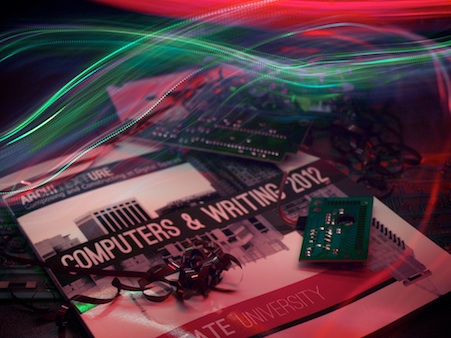
Figure 7: Dana, Robin, and Susan’s Final Light Painting
Dana noted how the process of creating each shot informed future composing choices while creating the next scene. Similar to the drafting process for written compositions, she used previous images as early drafts and refined her light painting style in subsequent shots (revisions). Her group chose to incorporate the Computers and Writing 2012 program along with pieces of old technologies into a light painting. While in the earlier drafts (not pictured) Dana's group used single bulb lights to compose, they discovered their light painting kit contained a snowflake shaped, color-changing LED and used it to light the scene in Figure 8.
At the beginning of the session, all of the groups played with the lights to see how to work in the dark room. The groups were exploring together to figure out what the tools did and how they could use them. By the end of the ConstrucTEXT session, the participants were using the knowledge gained as a way in which to sculpt and refine their compositions. They used the emotional charge of creating and waiting for the camera to "show them" their work as a springboard for further exploration. At the end of the workshop participants noted that, although generally the majority of them did not know how to use the specific cameras and had little to no background in photography, they weren't apprehensive about exploring and playing with the unfamiliar technologies. Because light painting was so unfamiliar of a process, it encouraged exploration of the materiality of the tools and objects. The final section outlines how readers can create a light painting kit to begin composing in the dark.
III. The Light Painting Kit
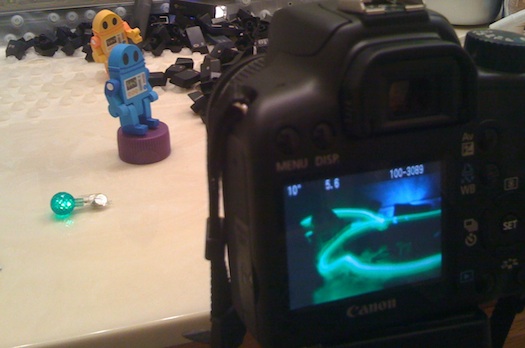
Figure 8: A Light Painting Kit
In order to build your own light painting you will need the follow:
- ?
- A camera with manual focus and extended exposure options
- Light sticks, holiday lights, glow sticks, or flashlights
- A dark environment
?
?
The light painting kit contains holiday lights of various shapes and styles along with LED key chains. These can be used as backdrop items as well as for painting. The LED key chains were modified so that they could be used as a "plug" for single Christmas bulbs (see Figure 9) and serve as paint brushes but it is also possible to simply tape a Christmas plug to a battery in order to create your own light painting brush.
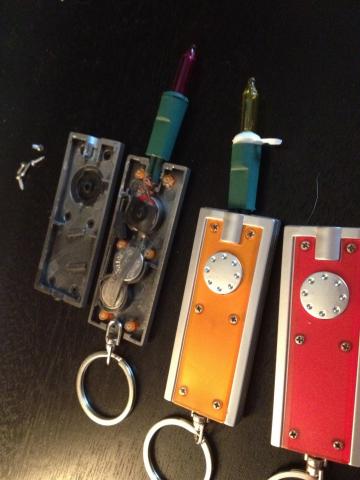
Figure 9: Modified Holiday Bulbs and LED keychains
Conclusion
By engaging our students with the inherently recursive composing process of light painting, we can start to revisit issues of materiality and bring it into the traditional revision process in a way that is more than outlining how a written draft is revised from rough to polished state. Revising a composition is largely regarded as a linear process that happens sequentially over time. Light painting on the other hand, brings the students back to the initial moment of composing and pushes them to explore how and why we choose to compose with specific materials and tools (Wysocki 19). Through light painting, we can start to reconceptualize the revision processes through the focus provided by the visual and material dimensions.
Students tend to approach the revision process with a mindset geared towards efficiency. Light painting brings back an emphasis on the moment of composing, which can bring forth opportunities to highlight that the “moment” of composing is not at all singular but that composing itself is an iterative, reflexive, and recursive process. Much like the camera can help us take snapshots of precise moments, shifting the materiality of composing texts through the lens of light painting can give us a new picture of our composing in progress as a process.
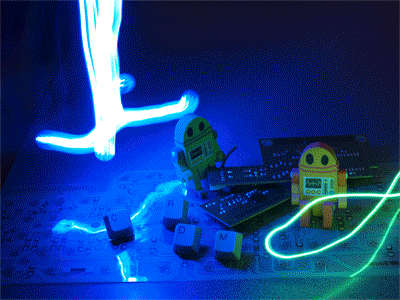
Figure 10: End: Refresh your page to see Dana, Robin, and Susan's robot light paintings in sequence
Works Cited
Aldwyth. Aldwyth?: Work V./work N.?: Collage and Assemblage 1991-2009. Charleston, S.C.: Halsey Institute of Contemporary Art, College of Charleston, 2009. Print.
Barthes, Roland. Camera Lucida?: Reflections on Photography. 1st American pbk. ed. New York: Hill and Wang, 1982. Print.
Davidson, Cathy N. Now You See It?: How the Brain Science of Attention Will Transform the Way We Live, Work, and Learn. New York: Viking, 2011. Print.
Engel, Adam. Message to the author. 27 May 2012. E-mail.
Gierdowski, Dana. Message to the author. 24 May 2012. E-mail.
Hall, Elizabeth Ashley. Message to the author. 26 May 2012. E-mail.
Murray, Joddy. Non-discursive Rhetoric?: Image and Affect in Multimodal Composition. Albany: SUNY Press, 2009. Print.
Shipka, Jody. To preserve, digitize and project: On the process of composing other people’s lives. Paper presented at Computers and Writing 2012. Raleigh, NC.
Snead, Robin L. Message to the author. 23 May 2012. E-mail.
Wysocki, Anne Frances. Writing New Media?: Theory and Applications for Expanding the Teaching of Composition. Logan: Utah State University Press, 2004. Print.